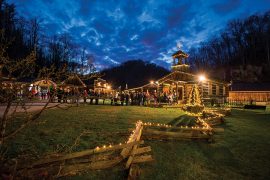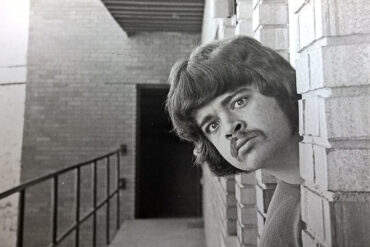Meet local legend Willis Cook whose striking black and white photography has earned him the title: “The Ansel Adams of Huntington.”
By Susan Hahn
HQ 53 | AUTUMN 2004
While readers of Huntington Quarterly might not recognize the name Willis Cook, they have seen his photography on the cover and throughout the magazine from the time the publisher discovered his body of work 13 years ago.
Cook’s striking black and white photos of Huntington transcend the years capturing the essence of the city and its defining influences.

Cook prefers to work in black and white because it allows more creativity. “Everything you do is your own work. A lot of magic happens in the dark room,” says Cook.

Many of Cook’s nature photographs of Ritter Park are reminiscent of Ansel Adams’ work, winning him the moniker, “The Ansel Adams of Huntington.” It is understandable since Cook cites Adams as an inspiration.
Cook’s patience in capturing nature’s details, the juxtaposition of form and texture revealed through light and shadow in a continual changing environment, creates elemental, personal interpretations of his subjects. In many of his photographs of the buildings in Huntington, Cook’s use of light and shadow yields an abstract, intrinsic rendition that is distinct. He logs countless hours in the dark room to yield the desired image.
Cook was born in Wyoming County and has lived in West Virginia most of his life with some notable detours. When he graduated from high school, he enlisted in the Navy becoming a Chief Petty Officer and served until the end of World War II.

When the war was over, he took a job at the Veterans Administration in Huntington and after a short stint, Cook was transferred to Logan to handle veteran affairs.
Cook met his wife Dee in Logan – they worked in the same office building. They married in 1946, and a year later they moved to Santa Barbara, Ca. so Cook could study at the Brooks Institute of Photography. He graduated with a major in illustration and advertising. Within a short span of time, these two events set Cook’s life on a path of happiness.
The Cook’s knew they would return to Huntington eventually. In 1951 they returned when Cook was offered the opportunity to be the first director of art and photography for WSAZ-TV. He helped produce the station’s first television commercials, gaining expertise with Swiss Bolex cameras, one of the first movie cameras. Cook also became known for his quick development methods enabling news film to be on the air in just a half hour or less.

In 1957 Cook accepted a job with the C&O Railway as the Manager for Public Relations in the company’s Southern Region.
As the company grew, Cook advanced in his job. In 1971 he was transferred to Washington, D.C. to serve as a liaison for the railroad with the media. In 1979, he returned to Huntington when he was promoted to Director of Public Relations for CSX.
During his years with the railroad, he continued to hone his photography skills. Not only did he provide many of the photos for the company’s annual report, his portraits of the board of directors were exceptional. The results were so good that the people in the public relations department in Cleveland called him “The Hillbilly Karsh.” Karsh of Ottawa was famous for his portraits of world leaders, artists, scientists and royalty including Churchill, JFK, Einstein, Ali, and Picasso to name a few. While his job kept him busy, Cook found time to do portraits of children in the community.

Cook always has been very involved in the community. He set up the photography department for the Huntington Museum of Art and taught the first photography classes. He also founded the Ohio Valley Camera Club and served as the organization’s first president. He was instrumental in bringing the Boys and Girls Club to Huntington and served on the first Board of Directors.
Cook retired in 1983 from CSX. He and his wife continue to be active in the community, involved in Enslow Park Presbyterian Church and many community organizations. Their son, Kevin, is an engineer with the Navy Department in Washington D.C., specializing in nuclear submarines and his wife is a nurse supervisor. The Cooks have two granddaughters, Jane, 15, and Christine, age 13.

Speaking about his continuing infatuation with the city he says, “Of course it has evolved structurally but there is a feeling about Huntington that I don’t think you can find in any other small city in America. It’s just a real fine place to be.”





